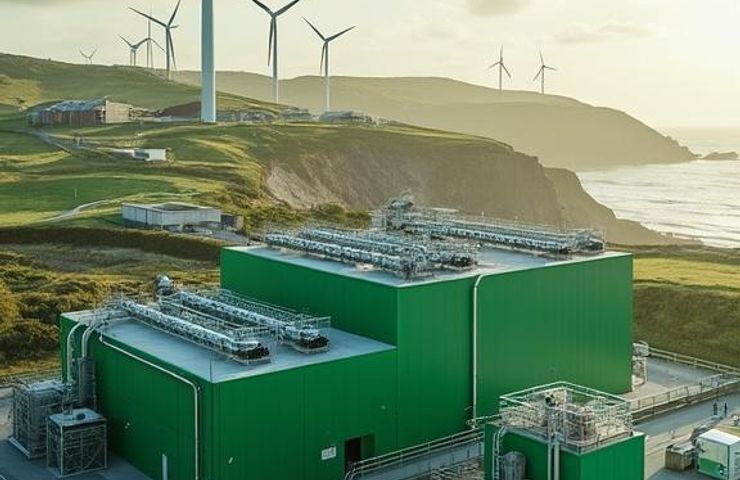
Green Hydrogen: Four Zeros Energy and Vergia Power UK’s Industrial Decarbonization
August 7, 2025An Historic County Embraces a Clean Future
Imagine you’re out on Cornwall’s craggy coastline, salty breeze in your hair and the ghostly outlines of old tin mines dotting the horizon. St Austell, where nearly 200,000 people live and locals shell out about $13,315 a year in rent, has always been a place steeped in mining lore and china clay heritage. But here’s where it gets exciting: instead of leaving those old industrial sites to rust, the town is eyeing them as prime real estate for green hydrogen production. It’s pretty wild to think that a place once defined by coal-tinged smokestacks could lead the charge in the energy transition.
Behind the scenes, Cornwall’s councils and local suppliers are gearing up to roll out electrolysers, tapping wind farms and solar arrays to churn out zero-emission hydrogen. With the UK government’s Hydrogen Allocation Rounds offering both funding and fast-track approvals, St Austell isn’t just a pilot—it’s a model for others to follow. Community colleges are launching training courses, and manufacturers are lining up to produce everything from pipelines to storage vessels. It’s a genuine all-hands-on-deck moment—proof that real change isn’t some far-off dream, but happening right now.
A Strategic Partnership Ignites Momentum
On August 5, 2025, a high-impact team-up was announced that’s set to turn heads among UK hydrogen projects. Four Zeros Energy, known for its knack in local project development, joined forces with Norwegian-backed Vergia, backed by the deep pockets and experience of Swiss Life Asset Managers. They’re not just aiming for a single plant in Cornwall—they’re lining up a string of green hydrogen installations across the UK. Four Zeros Energy brings local know-how, community connections, and a track record of navigating British planning hurdles, while Vergia chips in with cutting-edge electrolysis tech and patient capital. Together, these partners are rolling out a five-year roadmap to decarbonize heavy industry and boost regional energy security, setting the stage for a cleaner, more resilient grid.
The St Austell project snagged a coveted spot in the UK government’s hydrogen allocation lottery—Hydrogen Allocation Round 2, or HAR2—unlocking eligibility for up to 875MW of new electrolysis capacity nationwide. Legal advice from Shepherd and Wedderburn for Four Zeros Energy, coupled with counsel from Thommessen and Burges Salmon for Vergia, has built a rock-solid framework, reducing the usual headaches that come with big infrastructure deals. And with Swiss Life Asset Managers de-risking the early stages, this partnership is well-positioned to help the UK hit its 5GW green hydrogen milestone by 2030. It’s a serious shot in the arm for the nation’s push toward industrial decarbonization.
Scaling Up Green Hydrogen Production
Picture a massive warehouse not far from St Austell’s harbour, filled with modular stacks of electrolyser cells humming away. That’s the nerve center of green hydrogen production via electrolysis. Power from nearby wind turbines and solar arrays gets fed into these stacks, splitting H₂O into hydrogen and oxygen, with not a whisper of carbon emissions. These high-capacity electrolysers can be dialed up or down based on demand, which means they slot right into the local grid and even offer ancillary services like frequency balancing. It’s a far cry from the old days when power plants had to run flat-out, come rain or shine.
Thanks to its HAR2 nomination, St Austell could claim a sizeable chunk of that 875MW of electrolyser capacity—numbers that knock on the door of some of the largest gas-fired generators in the country, but without the pollution. The beauty of hydrogen is its versatility: you can store it in salt caverns or tanks for seasonal backup, pipe it to nearby industrial sites, or even convert it back to electricity when the wind’s died down. In effect, green hydrogen bridges the gap between variable renewables and the steady demands of heavy industry—delivering clean fuel whenever and wherever it’s needed.
Driving Industrial Decarbonization in Mining
Mining may be Cornwall’s lifeblood, but it’s also a major source of CO₂ emissions, especially from natural gas boilers and high-temp furnaces. The St Austell initiative is flipping the script by replacing those combustion systems with hydrogen-ready burners and fuel cells. That switch could virtually eliminate direct emissions at the point of use, knocking hundreds of thousands of tonnes of CO₂ off annual totals. It’s a crucial piece of the industrial decarbonization puzzle, showing how sectors that once seemed locked into fossil fuels can chart a new, cleaner course.
This transition taps into the UK Government’s broader net-zero vision for 2050 and illustrates hydrogen’s strategic role in hard-to-abate industries. Local mining operations, from china clay to aggregate processing, stand to stabilize energy costs and slash their carbon footprints, freeing up capex for further innovation. Plus, as hydrogen infrastructure comes online, there’s a ripple effect: valve manufacturers, pipeline installers, and transport firms all benefit from new contracts and a steady stream of work. Long-term, that means skilled jobs, a stronger supply chain, and an economy that’s more resilient to energy price shocks.
Broader Impacts and Future Outlook
Although St Austell is the initial focus, the vision stretches far beyond Cornwall’s borders. Four Zeros Energy and Vergia are plotting a nationwide network of UK hydrogen projects, eyeing industrial hubs from Teesside’s refineries to the steelworks around the Firth of Forth. The same playbook applies: tap local renewable resources, retrofit redundant industrial sites, and deploy modular electrolysis units. The result? Scalable decarbonization that can be tailored to different regions’ energy mixes and economic needs.
On the global stage, this partnership is a statement: green hydrogen is commercially viable, bankable, and ready to roll out at scale. Backed by the financial firepower of Swiss Life Asset Managers, these projects illustrate how private capital can dovetail with public policy to tackle climate goals head-on. In a world scrambling for practical clean-energy solutions, St Austell’s blueprint offers a glimpse of what’s next: an energy transition powered by water, wind, and sunshine, supported by smart regulation, and driven by real-world collaborations. It’s a story about reinventing the old for the new—and it’s only just getting started.



 With over 15 years of reporting hydrogen news, we are your premier source for the latest updates and insights in hydrogen and renewable energy.
With over 15 years of reporting hydrogen news, we are your premier source for the latest updates and insights in hydrogen and renewable energy.